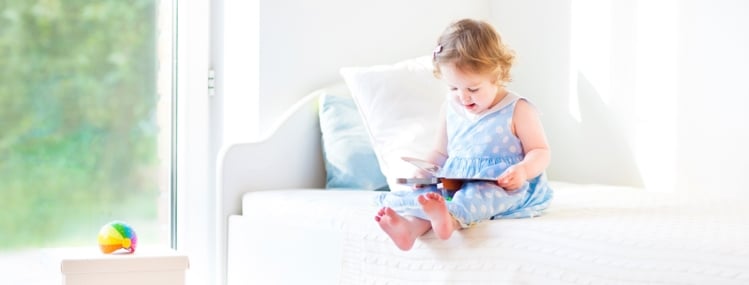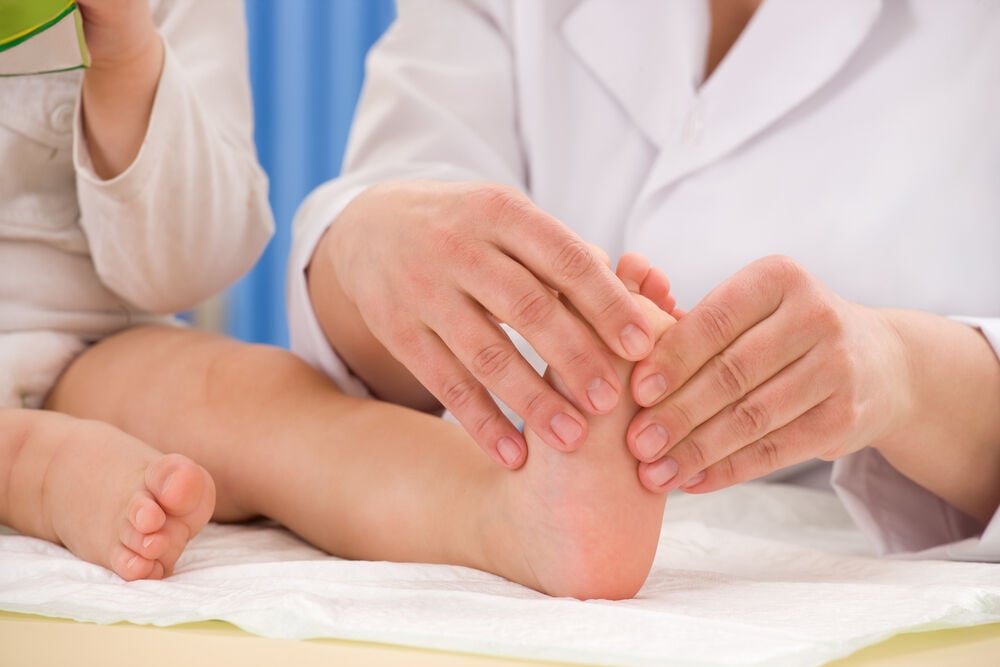Flat feet (or pes planus) in toddlers means exactly what the name implies — their feet are flatter on the bottom, allowing the entire sole of the foot to touch the floor when standing. Flat feet are entirely normal in babies and toddlers, primarily because the arches in their feet haven't fully developed. The anatomy, physiology and biomechanics of the baby's skeleton are different when compared to adults. Children's bones and joints are flexible, which causes their feet to flatten when they stand.
-
Tracking cycle
-
Getting pregnant
-
Pregnancy
-
Help Center
-
Flo for Partners
-
Anonymous Mode
-
Flo app reviews
-
Flo Premium New
-
Secret Chats New
-
Symptom Checker New
-
Your cycle
-
Health 360°
-
Getting pregnant
-
Pregnancy
-
Being a mom
-
LGBTQ+
-
Quizzes
-
Ovulation calculator
-
hCG calculator
-
Pregnancy test calculator
-
Menstrual cycle calculator
-
Period calculator
-
Implantation calculator
-
Pregnancy weeks to months calculator
-
Pregnancy due date calculator
-
IVF and FET due date calculator
-
Due date calculator by ultrasound
-
Medical Affairs
-
Science & Research
-
Pass It On Project New
-
Privacy Portal
-
Press Center
-
Flo Accuracy
-
Careers
-
Contact Us
Toddler Flat Feet: Symptoms, Causes, and Management of Baby Flat Feet


Every piece of content at Flo Health adheres to the highest editorial standards for language, style, and medical accuracy. To learn what we do to deliver the best health and lifestyle insights to you, check out our content review principles.
Flat feet in children: symptoms
You may feel stressed about how to fix flat feet in your toddler, but the truth is, flat feet is not necessarily a condition that needs to be fixed unless it's causing considerable discomfort.
Chasing a toddler around may make you exhausted, but having a child with flat feet is not something to feel guilty about. You should know that it is an extremely common condition, and only about 1 or 2 out of every 10 children continue to have flat feet into adulthood.
Many toddlers with flat feet experience no symptoms. Here are some examples for those who do:
- Foot pain, especially in the heel or arch of the foot
- Foot pain that gets worse with activity
- Ankle swelling
- Tight heel cords
If your toddler is experiencing foot pain and they have flat feet, you may want to consider talking to your child's doctor.
Causes of baby flat feet
Flat feet in toddlers may be caused by a variety of congenital and acquired factors. Some inherit the condition from their parents, and many other children are naturally born with them. As children's muscles strengthen, tissues stiffen and become less flexible, toddler flat feet typically correct themselves, and the arch of the foot gradually increases.
Problems occur when flat feet persist into adulthood and cause pain. This type of pain usually gets worse during vigorous activity, such as walking or running.
People can also develop flat feet later into adulthood, and some factors can increase the risk of developing flat feet, including being overweight, diabetes, foot or ankle injuries, and rheumatoid arthritis.
Baby flat feet: diagnosis

Toddlers with flat feet are usually diagnosed by their pediatrician. But if your toddler isn't experiencing pain or any other symptoms, no further treatment is usually necessary, since it's likely they'll grow out of it by the time they're about 2-3 years old.
If your toddler is experiencing pain, your pediatrician may recommend they see a foot specialist, particularly someone who specializes in pediatric foot conditions.
Typically, a child foot specialist examines your child's medical history, such as prior illnesses and any known allergies, and performs a complete physical and visual evaluation of your toddler. They may ask your child to describe the type of pain they're feeling, such as whether it feels dull, sharp, sudden (comes out of nowhere), or like a burning sensation. They may also ask whether there are activities that make the pain worse or what helps to make it better, if anything.
To better understand the mechanics of your toddler's feet, the doctor may ask them to walk, run, jump, or stand on their tiptoes to see how the feet look when performing these actions. It's also possible they'll ask to look at your child's shoes so they can examine wear patterns and possibly determine the cause of their pain.
If your toddler is experiencing serious foot pain, a doctor may order a number of tests to gain more insight and information. These include:
- X-rays
- Ultrasound
- CT scan
- MRI
Take a quiz
Find out what you can do with our Health Assistant
How to fix flat feet
There are options for fixing flat feet, but they're usually not recommended unless your child is experiencing a significant amount of pain and discomfort. If your child is not experiencing pain, further treatment isn't usually necessary. And remember — flat feet are extremely common in toddlers, so don't get too stressed. They usually disappear by the time they're 2 or 3 years old.
That being said, here are a few treatment options for children with flat feet.
Nonsurgical treatment
Nonsurgical treatment options for how to fix flat feet are numerous. These can help relieve pain.
- Arch supports: These are usually inserted inside your toddler's shoes to help relieve discomfort and other flat feet symptoms. Some are available over the counter, but there are custom-made versions too.
- Supportive shoes: Buying structurally supportive shoes can be helpful for children with flat feet.
- Stretching exercises.
- Physical therapy: Flat feet in older children can sometimes lead to injuries due to overuse, and physical therapists can help address these problems.
- Rest: Avoiding high-impact activities like running and jumping — which is extremely challenging if you're parenting an energetic toddler — can help with pain and discomfort.
- Medications: Sometimes over-the-counter medications, such as children's pain relievers, can help kids feel more comfortable.
Surgery
When conservative measures are unsuccessful surgery may be necessary to fix flat feet in toddlers, but this is not common. However, if your child has a related foot or leg problem, such as a torn tendon, bone problem, or other related condition, then surgery may be offered as an option. It's important to know that most of the time, surgery for toddler flat feet is not needed, as it's something that they either grow out of or, if it stays with them, doesn't cause pain and is just a unique part of them.
Flat feet kids: prevention
While there isn't a surefire way to fully prevent flat feet, there are some proactive measures you can take to make a flat-footed toddler feel as comfortable as possible. These include wearing supportive shoes that fit well and using arch supports if your pediatrician recommends it. If your child is overweight, sometimes this can make flat foot pain even worse, so a special diet may be recommended in some cases.
Toddler flat feet is not something to generally worry about. As your pediatrician is likely to tell you, your child is likely going to grow out of it by the time they're about 3 years old. And if they don't, that's all right too — you just have to help them manage any symptoms that might arise. But some kids who have flat feet never have any complications with pain or discomfort. If you're ever unsure about anything, you can ask your child's doctor for their opinion and recommendations.


Hey, I'm Anique
I started using Flo app to track my period and ovulation because we wanted to have a baby.


The Flo app helped me learn about my body and spot ovulation signs during our conception journey.


I vividly
remember the day
that we switched
Flo into
Pregnancy Mode — it was
such a special
moment.
Real stories, real results
Learn how the Flo app became an amazing cheerleader for us on our conception journey.




